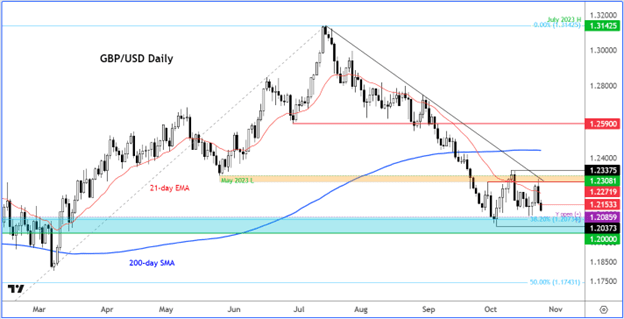By Fawad Razaqzada
The GBP/USD was unable to hold onto the small gains it made last week and on Monday, falling back in the last couple of days to remain rooted in the low 1.20s around 1.21ish.
However, with both the Fed and BoE rate decisions to come in the week ahead, it is clear that neither the bulls nor the bears will want to commit boldly in either direction.
Therefore, expect to see more chop and churn in the days ahead. FX traders will be paying close attention to US bond yields for clues about the near-term direction.
The GBP/USD outlook beyond the short term does not look very bright, given a sluggish UK economy and the potential for the impact of past UK rate hikes to further weigh on economic output.
Recent data releases from the UK argue against a big recovery in the pound. Therefore, if the GBP/USD were to make a meaningful comeback, it would have to be because of a potential sell-off in the US dollar across the board, rather than anything to do with the pound or the UK economy.
GBP/USD Outlook and UK Macro Pointers Remain Sluggish
Indeed, this week’s PMI data from the UK were far from convincing, with manufacturing sector activity falling for yet another month at 45.2, albeit at a slower pace than the previous month (44.3).
The services sector PMI remained below 50.0 for the third month running at 49.2. Meanwhile, jobless claims rose by 20.4K in September, way more than 2.3K expected, although August saw a favorable revision to -9.0K from 0.9K reported initially.
With economic activity remaining subdued, inflation in the UK remains a big problem. Last week, CPI came in ahead of expectations at 6.7%, unchanged from the previous reading.
This is way higher than most other developed economies, providing a big headache for the BoE rate-setters. But there was some good news on the wages front, as the average earnings index fell to 8.1% from 8.5%, more than expected.
Reflecting a weak consumer, retail sales were a shocker, falling another 0.9% on the month when a smaller drop of 0.3% was expected. The week before last saw UK GDP come in roughly in line, growing by 0.2% MoM in August following a downwardly revised 0.6% contraction in July after wet weather and strikes hit economic output.
The sluggish growth, falling retail sales, and weak PMIs all reinforce the picture of an economy that is losing steam in the face of 14 straight interest rate hikes from the Bank of England, hurting consumer spending and making it more expensive for businesses to invest.
So, looking ahead, the outlook remains weak. With forward-looking PMI data for October still flashing warning signs and with jobless claims on the rise, suggesting that the labor market is starting to cool, there is not much to get excited over.
On top of all this, given the lag time for interest rate hikes to work their way through the economy, the outlook for the last months of the year remains sluggish at best.
US Dollar in Focus Ahead of GDP, Core PCE
So far, every attempt to slam the US dollar has proven futile. This is because data in the US has remained relatively upbeat compared to the UK and Eurozone.
Take, for example, the last PMI data for October. While both the UK and Eurozone PMIs remained in contraction, the US services and manufacturing sector PMIs both came in above 50.0.
Similarly, most other US data pointers have been relatively better than European and Chinese data, keeping the “higher for longer” narrative alive. But with the dollar moving sharply higher in the last three months or so, most of the positivity may be priced in.
For the dollar to accelerate from here, it will take a lot more effort. Upcoming data releases will need to be significantly better than expected. Put another way, if upcoming US data were to disappoint, the US dollar’s downside reaction may well be more significant than would otherwise be the case.
The US economic calendar features an Advance GDP estimate on Thursday and the Core PCE Price Index on Friday. GDP is likely to garner most of the attention as investors assess the likelihood of one more rate increase from the Fed.
If GDP and this week’s other US macro pointers come in higher, then at the very least it would boost the “higher for longer” narrative, while data disappointment could finally send the US dollar and yields lower.
GBP/USD Outlook Remains Bearish
Heading into the final months of 2023, the GBP/USD outlook remains rather grim. While I can’t rule out the possibility of a short-term bounce given the dollar’s ‘overbought’ conditions, there is a real risk that the cable could be heading below 1.20 in the coming weeks and months.
Forward-looking UK macro indicators paint a gloomy picture for the UK economy, which means the Bank of England is unlikely to raise rates again even if inflation remains well above their target.
Meanwhile, a still-hawkish Fed, elevated risk aversion, and the potential for crude oil to resume higher should all help to keep the dollar supported on the dips.
GBP/USD Key Levels to Watch

The bearish trend line on the GBP/USD was tested and held earlier this week, keeping the technical bearish bias on the cable alive for now. Key resistance around 1.23ish, which was a major support level back in May, also held.
For the short-term trend to turn positive, we will now need to see a daily close above the 1.23 handle. If this happens, then a short-squeeze rally towards the 200-day average cannot be ruled out. Even so, the longer-term picture would remain bearish until something changes fundamentally.
Key support around the 1.20-1.21 area has held firm in recent weeks. But so far, we haven’t seen any aggressive buying, and rightly so, given the abovementioned macro risks. Therefore, the risks remain skewed to the downside.
However, given that the FOMC and BOE rate decisions will be taking place next week, the GBP/USD may hold onto support here for a while yet. If and when the cable breaks 1.2000, then watch out for a sharp follow-up technical selling pressure to ensue. In that case, the cable may well take out the March low en route to sub-1.18.
Originally published on MoneyShow.com
Editor’s Note: The summary bullets for this article were chosen by Seeking Alpha editors.
Editor’s Note: This article covers one or more microcap stocks. Please be aware of the risks associated with these stocks.
Read the full article here



